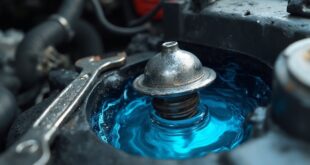A "Pre-Collision System Malfunction" in your Toyota means this essential safety feature isn't working properly, which could increase your risk of an accident. The system uses cameras and radar to detect potential collisions, alerting you when danger is near. If it's malfunctioning, it might not provide those alerts or engage emergency braking as intended. Regular maintenance and troubleshooting are key to keeping it in top shape, and you can discover more about ensuring its reliability.
Understanding the Pre-Collision System (PCS)
The Pre-Collision System (PCS) is an essential safety feature in Toyota vehicles, designed to help prevent accidents. Using front cameras and radar sensors, it detects potential collisions and alerts you with a flashing light.
If you don't respond in time, PCS can automatically engage emergency braking, reducing injuries and vehicle damage. This system is part of the Toyota Safety Sense suite, emphasizing your safety on the road.
How PCS Malfunctions Occur
When your Pre-Collision System (PCS) malfunctions, it can be due to several factors that interfere with its operation. Here are some common causes:
| Cause | Description |
|---|---|
| Dirty Sensors | Dirt or grime can obstruct radar and camera functionality. |
| Faulty Components | Malfunctioning sensors or cameras may cause errors. |
| Accidental Deactivation | You might inadvertently turn off the PCS. |
| Aftermarket Modifications | Changes to your vehicle can disrupt system performance. |
| Environmental Factors | Weather conditions can affect detection capabilities. |
Understanding these issues can help you identify potential problems with your PCS.
Regular Maintenance for PCS
To keep your Pre-Collision System (PCS) functioning well, regular maintenance is key.
Start by cleaning the radar and camera lenses frequently, as dirt and grime can obstruct detection. Consider car washes during winter and check your sensors after off-road driving to guarantee they're clear.
It's also wise to inspect for any aftermarket modifications that might interfere with the system.
Make a habit of scheduling routine inspections, and pay attention to any warning lights on your dashboard.
Staying proactive with maintenance helps guarantee your PCS remains reliable and effective, keeping you and your passengers safe on the road.
Troubleshooting PCS Issues
If you notice any issues with your Pre-Collision System (PCS), addressing them promptly can prevent potential safety hazards. Start by restarting the system using the Meter Control Switch on your steering wheel. Next, check for trouble codes with an OBD-II scanner. If problems persist, review recalls or Technical Service Bulletins (TSBs) for known issues. Here's a quick troubleshooting guide:
| Step | Action | Notes |
|---|---|---|
| 1. Restart System | Use Meter Control Switch | Simple reset may solve issues |
| 2. Check Trouble Codes | Use OBD-II scanner | Identify specific malfunctions |
| 3. Review Recalls | Consult manufacturer resources | Free repairs for known defects |
| 4. Seek Professional Help | Contact a trusted mechanic | For complex or persistent issues |
Disabling the Pre-Collision System
Addressing issues with the Pre-Collision System (PCS) is important, but sometimes disabling it's necessary to avoid false alerts in certain conditions, like snowstorms or off-road driving.
You can easily disable the PCS through your vehicle's multi-information display or using the steering wheel controls. When you turn it off, a warning will remain on the display, reminding you to stay vigilant.
It's a quick way to enhance your driving experience in tricky situations. Just remember to reactivate the system when conditions improve to guarantee you benefit from the safety features it provides.
Stay safe on the road!
Importance of Safety Alerts
While driving, safety alerts serve as essential indicators of your vehicle's system status, demanding your immediate attention. Ignoring these alerts can jeopardize your safety and that of your passengers.
Here's why you should take them seriously:
- Prevent Accidents: Alerts can help you avoid potential collisions by prompting you to take necessary actions.
- System Functionality: Malfunctions might indicate deeper issues that require prompt resolution.
- Peace of Mind: Addressing alerts guarantees a safer driving experience, allowing you to focus on the road ahead.
Stay vigilant and responsive to your vehicle's alerts for a safer journey every time you hit the road!
Seeking Professional Help for PCS Problems
Ignoring safety alerts can lead to serious consequences, especially when it comes to the Pre-Collision System (PCS).
If you notice any PCS malfunctions, don't hesitate to seek professional help. A qualified mechanic can diagnose the issue accurately, whether it's dirty sensors or a more complex problem.
Remember, quick repairs can enhance your peace of mind while driving. Research local mechanics online and read reviews to find someone reputable.
Avoid selecting a mechanic based solely on price; expertise matters when it comes to safety systems. Your safety and that of your passengers depend on a fully functioning PCS.
Frequently Asked Questions
Can I Drive With a Malfunctioning Pre-Collision System?
You shouldn't drive with a malfunctioning pre-collision system. It compromises your safety, as the system won't alert you to potential collisions. Prioritize repairs to guarantee your vehicle's safety features function properly while driving.
How Does Weather Affect the Pre-Collision System's Performance?
Weather can greatly impact your Pre-Collision System's performance. Rain, snow, or fog may obstruct radar and camera sensors, causing detection issues. Always verify your sensors are clean and functioning properly, especially in adverse conditions.
What Are the Costs Associated With Repairing PCS Malfunctions?
Repairing PCS malfunctions can vary widely in cost, usually ranging from $100 to $1,500. Factors include the type of issue, whether it's a sensor clean-up or a complete replacement, and labor costs at your mechanic.
Are There Any Recalls Related to the Pre-Collision System?
Yes, there are recalls related to the Pre-Collision System. You should check Toyota's official website or contact your dealership to see if your vehicle's affected and to schedule any necessary repairs.
How Can I Tell if My PCS Is Working Properly?
To tell if your Pre-Collision System (PCS) is working properly, monitor for warning lights on your dashboard, check for alerts while driving, and verify sensors are clean and unobstructed for accurate detection. Regular maintenance matters!
 Car Service Land Coupons for Oil change, Tires, Wheel alignment, Brakes, Maintenance
Car Service Land Coupons for Oil change, Tires, Wheel alignment, Brakes, Maintenance




